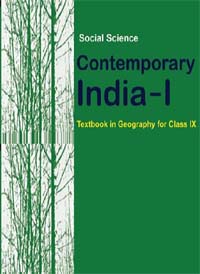Class 9 - Social Science : Contemporary India I
Chapter 5 - Natural Vegetation and Wild Life

Top Block 1
Question : 1 Define an Ecosystem.
Answer :
An ecosystem is a community of plants, animals and smaller organisms that live,feed, reproduce and interact in the same area or environment. Some ecosystems are very large. For example, many bird species nest in one place and feed in a completely different area . On the other hand, some ecosystems may be physically small, such as you would find in a meadow at he edge of a forest, or in a coral reef in the ocean.How does everything fit together in a forest ecosystem versus a meadow ecosystem? While some species may be found naturally in both areas, the species that live in the forest ecosystem are usually very different from those that inhabit the meadow, even though the two environments are right next to each other. In other words, if we protect existing natural habitats, we will help to maintain biodiversity (biodiversity is the variety of life in all its forms, levels and combinations). Unfortunately, natural habitats and their ecosystems are more and more endangered because of the damaging environmental effects of growing human populations everywhere.
Question : 2 What factors are responsible for the distribution of plants and animals in India?
Answer :
Distribution of plants and animals on the earth is determined mainly by climate. However the other factors are soil, relief and drainage, though most of them are also interrelated.
Question : 3 What is a bio-reserve? Give two examples.
Answer :
A protected area reserved for the conservation of endangered species of flora (plants) and fauna (animals) in their natural habitat. The Sunderbans in the West Bengal and Nanda Devi in Uttaranchal are the two examples.
Uses of Biosphere Reserve
(i) In a biosphere reserve, endangered species of animals and plants are protected.
(ii) This important heritage (of plants and animals) is transmitted to the future generations in all its natural vigour and glory.
(iii) The surrounding areas are reserved for research work for the betterment of flora and fauna.
Question : 4 Name two animals having habitat in tropical and montane type of vegetation.
Answer :
The common animals found in the tropical forests are elephants and monkeys and the common animals found in the montane forests are Kashmir stag and spotted dear.
Question : 5 Distinguish Between Flora and Fauna.
Answer :
♦ Flora
The flora of a country consists of plant kingdom of that country. It covers trees in the forests, other flowering and non-flowering frees grown by man, grassland, scrubs, fens, etc. India possesses about 47,000 different species of plants and 5,000 of them are exclusively found in India.
♦ Fauna
The fauna of a country consists of birds, fish and animals. It also includes amphibians, reptiles, mammals, small insects and worms. The fauna of India is quite rich and varied. There are about 89,000 species in India.
Question : 6 Distinguish Between Tropical Evergreen and Deciduous Forests
Answer :
♦ Tropical Evergreen Forests:
Evergreen forests (or Tropical Rain Forests) are found on the rainy parts of the Western Ghats and the island groups of Lakshadweep and the Andaman and Nicobar Islands.
Ebony, mahogany and rosewood are the most important trees of the Evergreen Forests.Teakis the most dominant species of the deciduous forests. Other trees found here are bamboos, sal, shisham, sandalwood and khair.
♦ Deciduous Forests:
Deciduous forests are found mostly in the eastern parts of the country – northeastern states along the foothills of the Himalayas, Jharkhand, West Orissa and Chhattisgarh and the eastern slopes of the Western Ghats.
Trees of the Evergreen Forests don’t shed their leaves at one and the same time, so these forests remain evergreen.The trees of the deciduous Forests shed their leaves for about six to eight weeks in summer.
Question : 7 Name different types of Vegetation found in India and describe the vegetation of high altitudes.
Answer :
The following major types of vegetation may be identified in our country:
(i) Tropical Rain Forests
(ii) Tropical Deciduous Forests
(iii) Tropical Thorn Forests and Scrubs
(iv) Montane Forests
(v) Mangrove Forests
The vegetation of high altitudes are Montane Forests. In mountainous areas, the decrease in temperature with increasing altitude leads to the corresponding change in natural vegetation. As such, there is a succession of natural vegetation belts in the same order as we see from the tropical to the tundra region. The wet temperate type of forests are found between a height of 1000 and 2000 metres. Evergreen broad-leaf trees such as oaks and chestnuts predominate. Between 1500 and 3000 metres, temperate forests containing coniferous trees like pine, deodar, silver fir, spruce and cedar, are found. These forests cover mostly the southern slopes of the Himalayas and places having high altitude in southern and northeast India.
At higher elevations, temperate grasslands are common. At high altitudes, generally more than 3,600 meters above sea level, temperate forests and grasslands give way to the Alpine vegetation. Silver fir, junipers, pines and birches are the common trees of these forests. However, they get progressively stunted as they approach the snow-line. Ultimately through shrubs and scrubs, they merge into the Alpine grasslands. These are used extensively for grazing by nomadic tribes like the Gujjars and the Bakarwals. At higher altitudes, mosses and lichens form part of tundra vegetation. The common animals found in these forests are Kashmir stag, spotted dear, wild sheep, jack rabbit, Tibetan antelope, yak, snow leopard, squirrels, Shaggy horn wild ibex, bear and rare red panda, sheep and goats with thick hair.
Mddle block 1
Question : 8 Quite a few species of plants and animals are endangered in India. Why?
Answer :
Quite a few animal species are endangered and some have become extinct. The main causes for this major threat to nature are hunting by greedy hunters for commercial purposes, pollution due to chemical and industrial waste, acid deposits, introduction of alien species and reckless cutting of the forests to bring land under cultivation and inhabitation, which are also responsible for the imbalance.
Question : 9 Why has India a rich heritage of flora and fauna?
Answer :
Our country India is one of the twelve-mega bio-diversity countries of the world. With about 47,000 plant species India occupies tenth place in the world and fourth in Asia in plant diversity. There are about 15,000 flowering plants in India, which account for 6 percent in the world’s total number of flowering plants. The country has many non-flowering plants such as ferns, algae and fungi. India also as 89,000 species of animals as well as a rich variety of fish in its fresh and marine waters.



